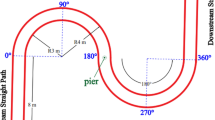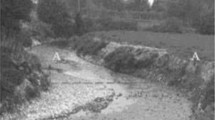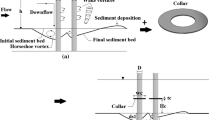Abstract
Scouring around the bridge's piers is one of the major causes of serious damage to the bridge pier. A laboratory modelling method has been utilized in this research to study the effect of level and thickness of collar on scouring around the pier. The experiments were carried out in a channel with a 180° bend and a relative curvature radius equal to 2. This channel is composed by the straight upstream- and downstream-directed paths, respectively, 6.5 and 5.1 m long and 1 m wide. All experiments were conducted with a constant discharge capacity equal to 0.07 m3⁄s. The obtained results indicated that the installation of the collar at the initial bed surface and 0.4 pier width under the initial bed level with thickness of 0.12 and 0.06 pier width helped gain the best results in reducing the amount of scouring when placing the pier at 90° of the bend. It also decreased 70% of the maximum depth of the scour hole in comparison with when the collar was not implemented. In the positions of 60° and 120°, the thickness parameter has no appreciable effect on scouring, and the best level of collar in this positions is same as the pier located at 90° of bend.


















Similar content being viewed by others
Abbreviations
- As:
-
Area of the main scour hole;
- B :
-
Channel width (m);
- b :
-
Wide of pier (cm);
- ds:
-
Scour depth;
- dsmax :
-
Maximum scour depth;
- \(d_{50} { }\) :
-
The average diameter of sediment particles (mm);
- hsmax :
-
Maximum sedimentary height;
- L :
-
Collar length;
- Lc:
-
Level of collar;
- Ls:
-
Length of the main scour hole;
- l :
-
Length of pier (cm);
- P :
-
Pier without Collar;
- R :
-
Central radius of the bend (m);
- Sd:
-
The slope of the downstream wall of scour hole;
- Si:
-
The slope of the scour hole that is near the inner bank;
- So:
-
The slope of the scour hole that is near the outer bank;
- Su:
-
The slope of the upstream wall of scour hole;
- t :
-
The time of the experiment;
- tc:
-
Thickness of collar;
- te:
-
Equilibrium time;
- t1:
-
Time when 70% of maximum scour depth occurs;
- t2:
-
Time when 90% of maximum scour depth occurs;
- U :
-
Flow velocity (cm/s);
- Uc:
-
Flow velocity under incipient motion conditions (cm/s);
- Vs:
-
Volume of the main scour hole;
- W :
-
Collar width;
- Ws:
-
Width of the main scour hole;
- y :
-
Upstream flow depth (cm);
- Z :
-
Distance from the bed (cm);
- \(\theta\) :
-
Angles from the beginning to the end of the bend (°);
- \(\theta_{P}\) :
-
Location of the pier in the bend (°);
- \(\propto\) :
-
Location of dsmax or hsmax (°)
References
Alabi PD (2006) Time development of local scour at a bridge pier fitted with a collar, MS thesis, Civil and Geological EngineeringDept., Univ. of Saskatchewan, Canada
Akib S, Liana Mamat N, Basser H, Jahangirzadeh A (2014) Reducing local scouring at bridge piles using collars and geobags. Sci World J. https://doi.org/10.1155/2014/128635
Ahmad N, Melville BW, Ahmad MT, Ali F, Yusuf B (2017) Scour geometry at long skewed bridge piers under shallow water flows. In: Proceedings of the Institution of Civil Engineers-Water Management, pp 1–12. Thomas Telford Ltd. https://doi.org/10.1680/jwama.15.00119
Ataie-Ashtiani B, Baratian-Ghorghi Z, Beheshti AA (2010) Experimental investigation of clear-water local scour of compound piers. J Hydraul Eng 136(6):343–351. https://doi.org/10.1061/(ASCE)0733-9429(2010)136:6(343)
Amini N, Balouchi B, Bejestan MS (2017) Reduction of local scour at river confluences using a collar. Int J Sedim Res 32(3):364–372. https://doi.org/10.1016/j.ijsrc.2017.06.001
Beg S, Beg M (2017) Application of Collars Around Bevel-Nosed Rectangular Pier. In: Development of Water Resources in India, pp 387–395. Springer, Cham. https://doi.org/10.1007/978-3-319-55125-8-33
Chiew YM, Melville BW (1987) Local scour around bridge piers. J Hydraul Res 25(1):15–26. https://doi.org/10.1080/00221688709499285
Chiew YM (1992) Scour protection at bridge piers. J Hydraul Eng 1189:1260–1269. https://doi.org/10.1061/(ASCE)0733-9429(1992)118:9(1260)
Chiew YM (1995) Mechanics of riprap failure at bridge piers. J Hydr Eng ASCE 121(9):635–643. https://doi.org/10.1061/(ASCE)0733-9429(1995)121:9(635)
Chavan R, Venkataramana B, Acharya P, Kumar B (2018) Comparison of scour and flow characteristics around circular and oblong bridge piers in seepage affected alluvial channels. J Mar Sci Appl 17(2):254–264. https://doi.org/10.1007/s11804-018-0016-6
Chen SC, Tfwala S, Wu TY, Chan HC, Chou HT (2018) A hooked-collar for bridge piers protection: flow fields and scour. Water 10(9):1251. https://doi.org/10.3390/w10091251
Deng L, Cai CS (2009) Bridge scour: Prediction, modeling, monitoring, and countermeasures. Pract Period Struct Des Constr 15(2):125–134. https://doi.org/10.1061/(ASCE)SC.1943-5576.0000041
Ettema R, Constantinescu G, Melville B (2011) Evaluation of bridge scour research: Pier scour processess and predictions, Washington D.C.: Transportation Research Board of the National Academies. https://doi.org/10.17226/22886
Ebrahimi M, Kripakaran P, Prodanović DM, Kahraman R, Riella M, Tabor G, Djordjević S (2018) Experimental study on scour at a sharp-nose bridge pier with debris blockage. J Hydraul Eng 144(12):04018071. https://doi.org/10.1061/(ASCE)HY.1943-7900.0001516
Fael C, Lança R, Cardoso A (2016) Effect of pier shape and pier alignment on the equilibrium scour depth at single piers. Int J Sedim Res 31(3):244–250. https://doi.org/10.1016/j.ijsrc.2016.04.001
Gogus M, Dogan AE (2010) Effects of collars on scour reduction at bridge abutments. In: Scour and Erosion, pp 997–1007. https://doi.org/10.1061/41147(392)100
GhorbaniKells BJA (2008) Effect of submerged vanes on the scour occuring at a cylindrical Pier. J Hydr Res 1:1–10. https://doi.org/10.3826/jhr.2008.3003
Ghiassi R, Abbasnia AH (2013) Investigation of vorticity effects on local scouring. Arab J Sci Eng 38(3):537–548. https://doi.org/10.1007/s13369-012-0337-8
Heidarpour M, Afzalimehr H, Izadinia E (2010) Reduction of local scour around bridge pier groups using collars. Int J Sedim Res 25(4):411–422. https://doi.org/10.1016/S1001-6279(11)60008-5
Izadinia E, Heidarpour M (2012) Simultaneous use of cable and collar to prevent local scouring around bridge pier. Int J Sedim Res 27(3):394–401. https://doi.org/10.1016/S1001-6279(12)60044-4
Imamzadehei AN, Heidarpour M, Imamzadehei MN, Ghorbani B, Haghiabi A (2016) Control of the local scouring around the cylindrical bridge pier using armed soil by geotextile. Int J Geosynth Ground Eng 2(1):5. https://doi.org/10.1007/s40891-016-0045-7
Johnson PA, Dock DA (1998) Probabilistic bridge scour estimates. J Hydraul Eng 124(7):750–754. https://doi.org/10.1061/(ASCE)0733-9429(1998)124:7(750)
Kumar V, Raju KGR, Vittal N (1999) Reduction of local scour around bridge piers using slots and collars. J Hydraul Eng 125(12):1302–1305. https://doi.org/10.1061/(ASCE)0733-9429(1999)125:12(1302)
Leschziner MA, Rodi W (1979) Calculation of strongly curved open channel flow. J Hydraul Div 105(10):1297–1314
Lauchlan CS, Melville BW (2001) Riprap protection at bridge piers. J Hydraul Eng 127(5):412–418. https://doi.org/10.1061/(ASCE)0733-9429(2001)127:5(412)
Melville BW (1984) Live-bed scour at bridge piers. J Hydraul Eng 110(9):1234–1247. https://doi.org/10.1061/(ASCE)0733-9429(1984)110:9(1234)
Melville BW, Sutherland AJ (1988) Design method for local scour at bridge piers, American Society of Civil Engineering. J Hydraul Div 114:10. https://doi.org/10.1061/(ASCE)0733-9429(1988)114:10(1210)
Melville BW, Hadfield AC (1999) Use of sacrificial piles as pier scour countermeasures. J Hydraul Eng 125(11):1221–1224. https://doi.org/10.1061/(ASCE)0733-9429(1999)125:11(1221)
Mashahir MB, Zarrati AR, Mokallaf E (2009) Application of riprap and collar to prevent scouring around rectangular bridge piers. J Hydraul Eng 136(3):183–187. https://doi.org/10.1061/(ASCE)HY.1943-7900.0000145
Oliveto G, Hager WH (2002) Temporal evolution of clear-water pier and abutment Scour. J Hydraul Eng 128(9):811–820. https://doi.org/10.1061/(ASCE)0733-9429(2002)128:9(811)
Omara H, Tawfik A (2018) Numerical study of local scour around bridge piers. In: IOP Conference Series: Earth and Environmental Science, vol 151, no. 1, p 012013. IOP Publishing. https://doi.org/10.1088/1755-1315/151/1/012013
Pandey M, Sharma PK, Ahmad Z, Singh UK (2018) Experimental investigation of clear-water temporal scour variation around bridge pier in gravel. Environ Fluid Mech 18(4):871–890. https://doi.org/10.1007/s10652-017-9570-8
Tafarojnoruz A, Gaudio R, Dey S (2010) Flow-altering countermeasures against scour at bridge piers, a review. J Hydraul Res 48(4):441–452. https://doi.org/10.1080/00221686.2010.491645
Tipireddy RT, Barkdoll BD (2018) Scour reduction by air injection at a cylindrical bridge pier: experimental determination of optimal configuration. J Hydraul Eng 145(1):06018016. https://doi.org/10.1061/(ASCE)HY.1943-7900.0001555
Unger J, Hager WH (2006) Riprap failure at circular bridge piers. J Hydraul Eng 1324:354–362. https://doi.org/10.1061/(ASCE)0733-9429(2006)132:4(354)
Vaghefi M, Ghodsian M, Salimi S (2016) Scour formation due to laterally inclined circular pier. Arab J Sci Eng 41(4):1311–1318. https://doi.org/10.1007/s13369-015-1920-6
Vaghefi M, Moghanloo M, Dehghan D, Keshavarz A (2017) Experimental study of the effect of base-level fall at the beginning of the bend on reduction of scour around a rectangular bridge pier located in the degree sharp bend. J Hydraul Struct 3(2):32–46. https://doi.org/10.22055/jhs.2018.24900.1065
Vaghefi M, Motlagh MJTN, Hashemi SS, Moradi S (2018) Experimental study of bed topography variations due to placement of a triad series of vertical piers at different positions in a 180° bend. Arab J Geosci 11(5):102. https://doi.org/10.1007/s12517-018-3443-4
Vijayasree BA, Eldho TI, Mazumder BS, Viswanadham BVS (2018) Effectiveness of combinations of raft foundation with aprons as a protection measure against bridge pier scour. Sādhanā 43(2):21. https://doi.org/10.1007/s12046-018-0784-3
Wang H, Tang H, Liu Q, Wang Y (2016) Local scouring around twin bridge piers in open-channel flows. J Hydraul Eng 142(9):06016008. https://doi.org/10.1061/(ASCE)HY.1943-7900.0001154
Zarrati AR, Gholami H, Mashahir MB (2004) Application of collar to control scouring around rectangular bridge piers. J Hydraul Res 42(1):97–103. https://doi.org/10.1080/00221686.2004.9641188
Zarrati AM, Nazariha M, Mashahir MB (2006) Reduction of local scour in the vicinity of bridge pier groups using collars and riprap. J Hydraul Eng ASCE 132(2):154–162. https://doi.org/10.1061/(ASCE)0733-9429(2006)132:2(154)
Zarrati AR, Chamani MR, Shafaie A, Latifi M (2010) Scour countermeasures for cylindrical piers using riprap and combination of collar and riprap. Int J Sedim Res 25(3):313–322. https://doi.org/10.1016/S1001-6279(10)60048-0
Author information
Authors and Affiliations
Corresponding author
Rights and permissions
About this article
Cite this article
Moghanloo, M., Vaghefi, M. & Ghodsian, M. Experimental Study on the Effect of Thickness and Level of the Collar on the Scour Pattern in 180° Sharp Bend with Bridge Pier. Iran J Sci Technol Trans Civ Eng 46, 535–553 (2022). https://doi.org/10.1007/s40996-020-00511-9
Received:
Accepted:
Published:
Issue Date:
DOI: https://doi.org/10.1007/s40996-020-00511-9




